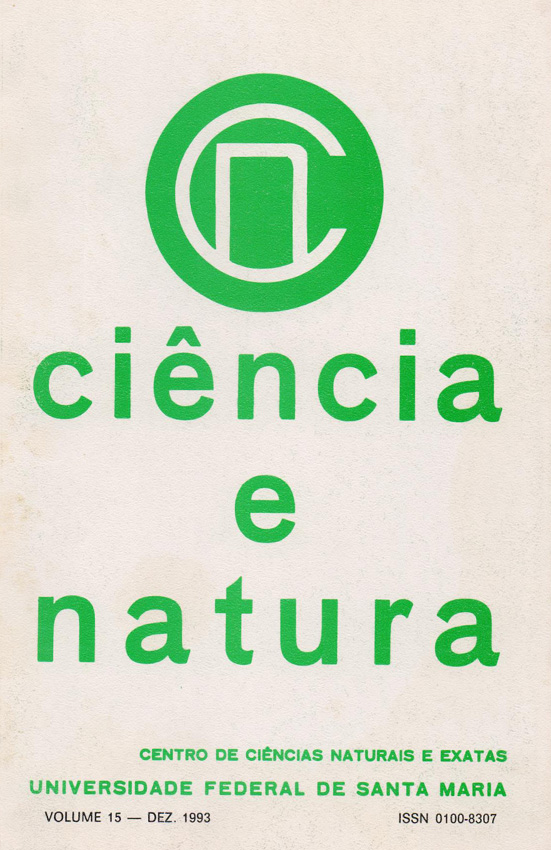Electrochemical evidence of the influence of light on the corrosion processes of low-carbon steel in diluted sulfuric acid
DOI:
https://doi.org/10.5902/2179460X26356Keywords:
Photocorrosion, low carbon steel, diluted sulfuric acidAbstract
Two different electrochemical methods confirm the influence of ligth on the anodic current values observad when low carbon steel electrodes were polarizad in deaerated 1.0 N H2SO4 solutions in the anodic potential range. The highest density values were obtained when the system is under illumination. The effect of natural illumination conditions on the weigh-loss experiments in aerated 1.0 N H2SO4, confirms that the corrosion rate is higher in an illuminated medium than in the dark.Downloads
References
BARD, A. J. (Editor) Photoelectrochemistry and Electroluminescence in Electroanalytica7 Chemistry, Marcel Dekker, 1966. 197 p.
ARBIT, H.A. and NOBE, K. Photopotential measurements during corrosion of copper in aqueous solutions. Corrosion (NACE), 24 (1),17-23 (1968).
WILHELM, S.M.; TANIZAWA, Y.; LIU, C. and HACKERMAN, N. A photo-electrochemical investigation of semiconducting oxide films on copper. Corrosion Science, 22(8), 791-805 (1982).
ULRICH, R.K. and ALKIRE, R.C. The initiation of sinqle corrosion sites on iron by focused laser illumination. Corrosion Science, 23(11), 1153-62 (1983).
BASTIDAS, J.M. corrosion phenomena: and SCANTLEBURY, J.O. The influence of light on the behaviour of mild stee7 in citric acid solution. Corrosion Science, 26(5), 341-47 (1986).
MARSH, G.P.; TAYLOR, K.J.; BRYAN, G. and WORTHINGTON, S.E. The influence of radiation on the corrosion of stainless steel. Corrosion Science, 26(11), 971-82 (1986).
SPINELLI, A. and GONÇALVES, R.S. Electrochemical studies of the adsorption of propargyl alcohol on low carbon steel electrodes in H2S04 solutions. Corrosion Science, 30(12), 1235-46 (1990).
FONTANA, M.G. & GREENE, N.D. Corrosion Engemeering, McGraw-Hill Book Company, 1967. 342 p.
GERISCHER, H. Models for the discussion of the photo-electrochemical response of oxide layers on metals. Corrosion Science, 29(2/3), 257-66 (1989).
Downloads
Published
How to Cite
Issue
Section
License
To access the DECLARATION AND TRANSFER OF COPYRIGHT AUTHOR’S DECLARATION AND COPYRIGHT LICENSE click here.
Ethical Guidelines for Journal Publication
The Ciência e Natura journal is committed to ensuring ethics in publication and quality of articles.
Conformance to standards of ethical behavior is therefore expected of all parties involved: Authors, Editors, Reviewers, and the Publisher.
In particular,
Authors: Authors should present an objective discussion of the significance of research work as well as sufficient detail and references to permit others to replicate the experiments. Fraudulent or knowingly inaccurate statements constitute unethical behavior and are unacceptable. Review Articles should also be objective, comprehensive, and accurate accounts of the state of the art. The Authors should ensure that their work is entirely original works, and if the work and/or words of others have been used, this has been appropriately acknowledged. Plagiarism in all its forms constitutes unethical publishing behavior and is unacceptable. Submitting the same manuscript to more than one journal concurrently constitutes unethical publishing behavior and is unacceptable. Authors should not submit articles describing essentially the same research to more than one journal. The corresponding Author should ensure that there is a full consensus of all Co-authors in approving the final version of the paper and its submission for publication.
Editors: Editors should evaluate manuscripts exclusively on the basis of their academic merit. An Editor must not use unpublished information in the editor's own research without the express written consent of the Author. Editors should take reasonable responsive measures when ethical complaints have been presented concerning a submitted manuscript or published paper.
Reviewers: Any manuscripts received for review must be treated as confidential documents. Privileged information or ideas obtained through peer review must be kept confidential and not used for personal advantage. Reviewers should be conducted objectively, and observations should be formulated clearly with supporting arguments, so that Authors can use them for improving the paper. Any selected Reviewer who feels unqualified to review the research reported in a manuscript or knows that its prompt review will be impossible should notify the Editor and excuse himself from the review process. Reviewers should not consider manuscripts in which they have conflicts of interest resulting from competitive, collaborative, or other relationships or connections with any of the authors, companies, or institutions connected to the papers.






